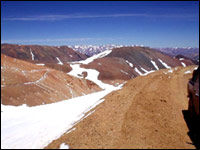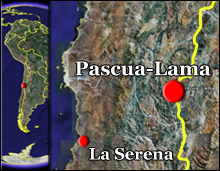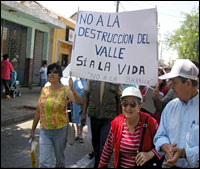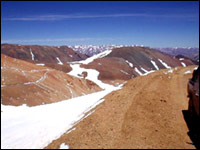Last week, Chile’s government green-lighted a controversial mining project known as Pascua-Lama. If the name rings a bell, odds are a chain email has found its way to your inbox, an appeal to “friends who care about our earth.”

Activists hoped Chile’s new
president, Michelle Bachelet,
would stop the mine.
Photo: Queen/ WireImage.com.
The far-reaching cyber-alert describes a messy international situation. Indigenous farmers in the mountainous Andean border between Argentina and Chile, it says, are fighting an international company that plans to mine for gold beneath massive glaciers. Doing so, the letter continues, will contaminate two key rivers fed by the glaciers, ruin water systems for the area’s impoverished people, and line the pockets of yet another foreign corporate invader. Oh, and the mining company has ties to the elder George Bush.
The message’s rounds have been so extensive that hoax-busting websites investigated, and they now report what folks in South America have long known: Pascua-Lama is very real. The proposed open-pit mine would sit at an elevation of about 15,000 feet, yielding an estimated 18 million ounces of gold and 685 million ounces of silver over 20 years. The brainchild of Canada’s Barrick Gold, it would be the world’s first binational mine, and is slated to begin operations in 2009.
Though the email played loose with some facts, it was enough on target to prick Barrick into crafting a point-by-point rebuttal — choosing to clarify, for instance, that former U.S. President Bush served in an “honorary capacity as an adviser to Barrick’s international advisory board for two years in the mid-1990s” and “was neither a director nor officer of the company.”
But other than causing a PR headache, the e-protest has failed to make real-space dents. Now that the government of Chilean President Michelle Bachelet has given Pascua-Lama the OK — rejecting 44 of 46 complaints filed by local opponents after Barrick’s environmental impact study was initially approved in February — the company simply awaits a nod from Argentina. That country, which would host one quarter of the mine, has left the decision in the hands of provincial officials who are said to favor the deal.
While opposition to Pascua-Lama continues in the form of lawsuits filed by indigenous-rights groups, last week’s decision drained many green hopes. It was, however, a feather in the cap of Barrick’s public-relations team.
For well over a year, Barrick has worked to break the ice with locals — who it says wrongly believe the mine will hurt water supplies — and to dispel the concerns of activists around the world.

It’s just an “ice reservoir” — what’s
the big deal?
Photo: Eduardo Ubal, courtesy of OLCA.
Vince Borg, the company’s vice president for corporate communications, declined to comment for Grist. However, he has worked through other media channels to downplay negative portrayals of the project — stressing, for example, that glaciologists declared that the ice fields in question were not glaciers, but “ice reservoirs.” Barrick has also worked to counter claims that the entire lode is located under ice. “This is simply not the case,” says the company’s rebuttal to the chain mail. “[Ninety-five percent] of the orebody is not under glaciers/ice fields. Protection of the remaining 5 percent is a key condition of the Chilean authorities’ approval of the project.”
Ana Lya Uriarte, director of the Chilean environmental commission that gave the approval, assured local media last week that the glaciers “would not be removed, transferred, or interfered with, much less destroyed.” And Barrick Chile Director Jose Antonio Urrutia issued a statement saying that “as with all of its other operations around the world, in Chile Barrick will maintain its philosophy of responsible mining.”
But those promises are worth a bucket of melting ice to Lucio Cuenca of the Chile-based Latin American Observatory of Environmental Conflicts. “People don’t have trust in the government, and the [government’s announcement] is rhetorical, saying only that there will be no harm done to the glacier,” Cuenca says. “But the deposits are under or near the glaciers, so it is very hard to believe they are not going to destroy [them].” Another major concern for activists is the plan to use a common mining technique involving cyanide, which they worry could contaminate local river systems.
For now, opposition groups are pinning their remaining hopes on Argentine authorities. But Raúl Montenegro, president of the Foundation for the Defense of the Environment in Cordoba, Argentina, says local mining officials “are conditioned by political power” and have already made up their minds. He says the technical capacity of Argentina’s regulatory machine is lower than Chile’s, and accuses Barrick of giving Argentine officials an inferior environmental impact study. “There were two reports filed, and two different levels of information,” he says. “It was much deeper for [the] Chilean side.”

The controversial lode lies about 400
miles north of Santiago.
What’s more, Montenegro says, Argentina’s federal mining agency is legally bound to involve itself in Barrick’s request. He says leaving the decision to lower-level officials is a way of giving tacit approval while keeping hands clean in the capital, Buenos Aires. San Juan, the province in question, approved a nearby mine also run by Barrick in 2003 — an ominous bellwether, Montenegro says.
Ana Folgar of Argentina’s Mining Secretariat confirmed that the decision has been placed in the hands of officials in San Juan, and referred Grist to them for comment. Those officials did not respond to interview requests.
It’s the Economy, Estupido
Understandably, Barrick has played up the economic benefits for locals, promising 5,500 new jobs during the construction stage and 1,660 when the mine is up and running. In addition, the company estimates that each of those jobs will lead to the indirect creation of 2.5 more jobs in the local economy. For any developing country, that kind of promise makes environmental decisions even more complicated.

Residents of Vallenar, Chile, protest
plans for the Pascua Lama mine.
Photo: Natanael Vivanco
Critics say Pascua-Lama is another example of how permissive national laws, lax environmental enforcement, cheap labor, and peaking ore prices are prompting a modern-day gold rush in South America, home to some of the world’s most sensitive ecosystems. And as indigenous groups, farmers, and greens butt heads with multinational mining interests and royalty-hungry governments in Argentina, Chile, and Peru, the money machine keeps turning.
A Canada-based consultancy, Metals Economics Group, reports that in 2005, nearly a quarter of worldwide mining exploration budgets — which totaled $4.89 billion — found their way to Latin America, making the region “the most popular destination for exploration.” Victor Di Meglio, director of the Argentine Mining Chamber, a trade group, told reporters last year that he expects investments of $4.5 billion in Argentina alone over the next five to six years. Chilean officials reportedly expect mining investments to total $10 billion by 2008, and Peru’s prospects aren’t far off that mark, according to reports.
Those figures give the shakes to activists who say unemployment, poverty, and corrupt governments spell an all but open road for potential environmental abuse. And they are bound and determined to keep Pascua-Lama from being added to the list.
According to Mines and Communities — an international coalition created by three British-based organizations — the Pascua-Lama fight isn’t over. Legal actions are under way to nullify the environmental-impact approval granted by Chile in February — and even to challenge the legitimacy of the treaty between Chile and Argentina that laid the foundations for this project in the first place.
So What Can You Do?
Those involved in the battle over Pascua-Lama say you shouldn’t count on email saving the day. “This is a local fight,” says Lucio Cuenca of the Latin American Observatory of Environmental Conflicts. “The awareness has been welcome, but I am afraid it doesn’t do much on the local level.”
However, the organizations involved do need support, say activists, including financial donations. To learn more about the situation, visit Mining Watch Canada.


